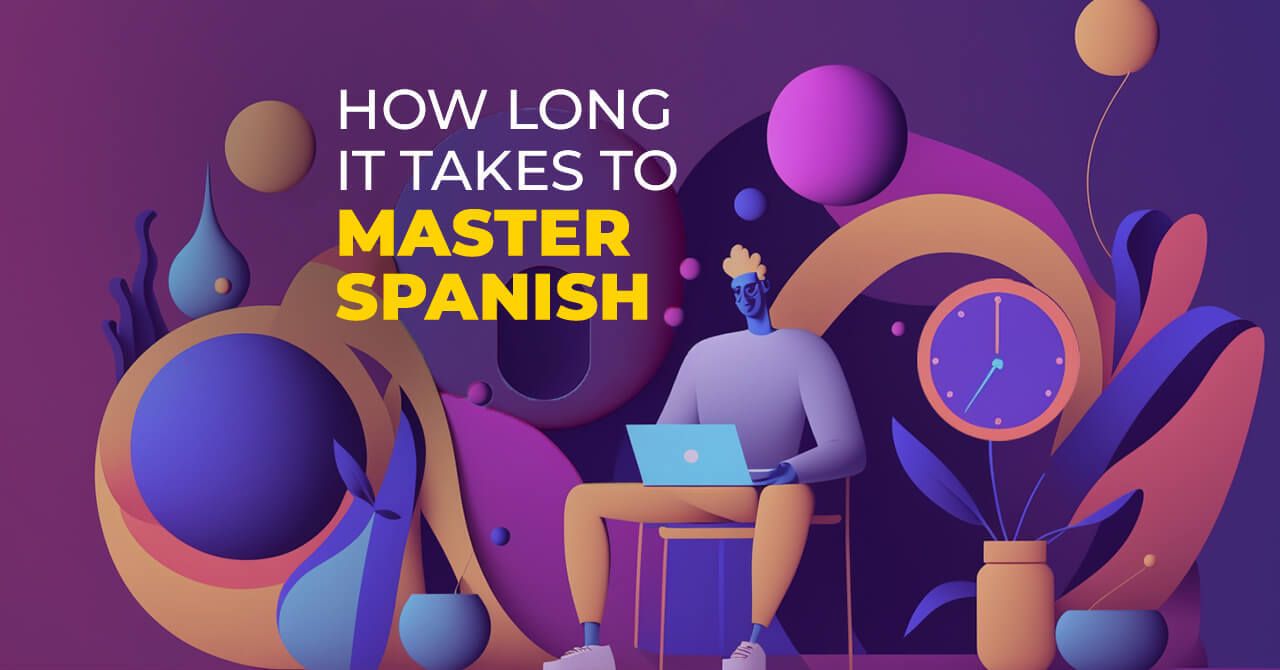
How Long It Takes to Learn Spanish [Revealed]
Before we discuss how fast you can learn Spanish, let’s explain the factors that can affect the language learning time frame.
There might be various reasons why you may want to master Spanish. Whether that’s getting more out of your trips or boosting your resume, mastering the language will definitely help you out. The question that many people ask Google or a teacher before they start is, “How long does it take to learn Spanish?”
Wanting to know how much time learning a foreign language requires is completely normal. After all, we live in a busy world, so we don’t want to waste too much of our time on one thing. If you know the answer and you’re ok with it, it can motivate you to start mastering the language and be persistent until you reach the desired level of fluency.
But before we discuss how fast you can learn Spanish, let’s explain the factors that can affect the time frame.
How long does it take to become fluent in Spanish? Factors to consider
Spanish may not be one of the most difficult languages to learn, especially for English speakers, but it does require time, effort, and persistence on your part. What’s more, we’re all different, with some of us being better at language learning than others.
So, to answer the question of how much time you need to become fluent in Spanish, you have to consider the following factors.
The time required to learn Spanish depends on the target fluency level
If your goal is to study Spanish for travel, you’ll probably need a few days or weeks to memorize some common words and phrases. But if you want to become fluent, it’ll probably take you a lot longer.
When you talk about learning, how well do you want to speak—like a native or just well enough to have a small talk? Many people aim to be “fluent” in Spanish, but fluency can mean different things. So, what do we really mean by fluency?
When you’re conversationally fluent, you pronounce words clearly and correctly, and native Spanish speakers can comprehend you with ease.
That’s great if you aim to reach a native-like Spanish level. But it could be more helpful to set realistic goals if you’re starting out. Your big goal can be split into smaller but achievable goals. This approach will help you master Spanish step by step and save you from frustration and disappointment.
Your private Spanish tutor on LiveXP will gladly help you figure out what steps you need to take to become closer to your big goal of language mastery. This way, you’ll create a learning plan for Spanish fluency. You can take these steps in private lessons with a tutor and reach your destination.
Learning pace influences the time to learn Spanish
The truth is quite easy—the more hours you spend on learning the language, the faster you’ll get it. Basically, if you spend a few hours each week studying Spanish regularly, you’ll learn it quicker than if you only spend a few minutes. Setting aside a couple of hours a week to focus on Spanish will really speed up your progress.
Remember, everyone learns at their own speed, and that’s totally okay! However, the problem you can face here is a lack of flexibility and personalization. If you choose group classes or courses, most likely, it’s not up to you to study Spanish at your own pace. LiveXP can be one of the most flexible solutions, as you can pick how fast you go. It’s up to you to decide how many lessons you want each week and how long they should be. Learn not in the RIGHT way but in YOUR way. Embrace your own pace of learning, and you’ll see your efforts pay off.
The right learning methods greatly impact how fast someone can learn Spanish
Are you going to get online classes with a native-speaking tutor, use an app, or maybe learn it on YouTube? Every learning method can bring its own results in one way or another, but the question is how far they can get you compared to your goal. As we’ve already mentioned, you need to have a step-by-step plan on how to become fluent in Spanish. So, to achieve it in the desired timeframe, you need to choose the methods wisely.
A private Spanish tutor, for example, will help you pick up the language faster than self-studying. On LiveXP, you can choose any Spanish tutor you like, whether they’re native speakers or English-speaking teachers. You learn at your own pace, and you can schedule the lessons whenever you want. Suppose you’re interested in improving your speaking skills. In that case, it’s great that LiveXP allows you to look for tutors by interest so you can discuss your hobbies with teachers practicing Spanish and expanding your vocabulary. Just try, and you’ll see it’s worth your time!
How long does it take an English speaker to learn Spanish?
Spanish is often called the easiest language for English speakers to learn. In fact, this is not always valid. But your native language and your previous experience in studying other languages greatly impact the time to learn Spanish.
Being an English speaker, if you dedicate 3 hours every day to learning Spanish, you might become fluent in about 6 months. But if you only study for 1 hour a day, it could take around a year and a half to learn, according to the Foreign Service Institute.
However, these estimates are based on classroom learning. We all know that learning doesn’t just happen in the classroom. Often, what happens outside the classroom has a bigger impact on how we study.
On LiveXP, you learn not only during the class. You have the Word Trainer feature that helps you memorize and practice new Spanish words. This feature reminds you to practice new words every day. The LiveXP blog in Spanish can help develop your reading skills and expand your vocabulary. Every time you meet an unknown word, open the Word Trainer and add this word to your list. In the LiveXP Community section, you can ask any Spanish-related question to get an immediate answer from a tutor. This way, you won’t have to wait for your next lessons to find out something new and interesting about Spanish.
Native Spanish speakers can speed up the learning process
When you’re surrounded by native Spanish speakers, you’ll pick up the language a lot faster. Even if you can’t go to a Spanish-speaking country, talking with some Spanish-speaking friends or tutors regularly will definitely speed up your learning process.
Practicing with native Spanish-speaking tutors in private lessons on LiveXP will greatly impact your Spanish language skills:
- You’ll inevitably get used to the Spanish speech and accent.
- Boost your listening skills.
- Expand your vocabulary and speaking skills.
- Greatly improve grammar.
1-on-1 lessons with native Spanish speakers on LiveXP are your “golden hours” to acquire knowledge and boost your skills, as the tutor’s attention is yours.
How many hours does it take to learn Spanish?
It is estimated that beginners can reach conversational fluency in Spanish within 250 to 350 hours or 8 to 12 months. Of course, they need to be consistent and dedicate at least one hour a day to mastering the language. This time period can vary depending on the method you choose and whether you’re immersed in the language or not.
So, if you attend online classes with a private Spanish tutor at least twice a week and live in a Spanish-speaking country, you’ll probably master the language in less time, maybe even within a few months. Once again, this is individual and depends on several factors, including your fluency in another language similar to Spanish, such as English.
This is why English speakers usually take less time to learn it than others, as long as they are consistent and dedicate at least one hour a day to Spanish.
When it comes to experts, the U.S. Foreign Services Institute (FSI) estimates that becoming fluent in Spanish takes around 600 classroom hours. They point out that learning the language outside the classroom is just as important as doing it in the classroom.
So, this means the total time devoted to language learning should be around 1200 hours, which is exaggerated and probably wrong. That’s because the traditional classroom is considered to be one of the most inefficient ways to learn a foreign language. This is why it’s best to ignore the outdated FSI statistics and focus on getting enough conversation practice with an online tutor or native Spanish speakers.
The bottom line is that becoming fluent in Spanish won’t take as long as you think. As long as you devote enough time to studying it and using the right methods, you should expect to learn it within a few months or a year.
I’m a young copywriter who likes helping people by finding easy answers to difficult questions. What I do is diving into the topic and explore it.

